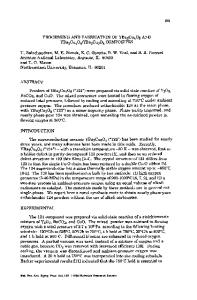TEM studies on twin boundary in YBa 2 Cu 3 O 7 and YBa 2 (Cu 0.98 M 0.02 ) 3 O 7 (M = Zn, Al)
- PDF / 1,447,227 Bytes
- 8 Pages / 593.28 x 841.68 pts Page_size
- 3 Downloads / 319 Views
I. INTRODUCTION
Since the discovery of high Tc superconductivity in YBa2Cu3O7, extensive studies have been carried out to understand the superconducting and structural properties of the oxide by means of electron microscopy and other techniques. Twinning, a prominent feature in the structure of this material, has been presumed to be important in determining its superconducting properties, particularly its critical current density. For example, it has been argued that the twin boundary is an area of weak superconductivity and thus that magnetic fields can freely penetrate through the boundary.1'2 However, it has also been argued that twin boundaries are flux pinning sites for achieving high critical current densities in the oxides.3"6 On the other hand, some reports suggest that the twin boundary may act as a diffusion path for oxygen.7'8 It is therefore of interest to study the twin boundary in detail to understand the correlation between the structure and the superconducting properties. It is well known now that in YBa2Cu3O7 crystals, twins are formed along (110) directions to accommodate the strain energy of the tetragonal to the orthorhombic phase transformation as increasing oxygen is absorbed by the oxide when it is cooled from high temperature in an O2 atmosphere. At the twin boundary, the two axes (a and b) in the basal plane of the orthorhombic structure alternate across the (110) boundaries. Our previous electron diffraction studies9 on twin boundaries in YBa^Cui-^M^O-z-s, where M = Zn, Al, Ni, and Fe, indicated the existence of nonorthorhombic twin boundary layers. The layer thickness depends on the doping element and oxygen content. It varied from ~1 nm for a pure YBa2Cu3O7 and M = Ni and Zn and x = 0.02, to -2.5 nm for M = Al and Fe and x = 0.02. Furthermore, direct observation of a twin boundary by high resolution electron microscopy 1380
http://journals.cambridge.org
and optical diffraction from one twin boundary supported the existence of such twin boundary layers.1011 In the present paper, we report a further investigation on the structure and the nature of strain of the twin boundary in YBa2Cu3O7. In particular, the structure of the boundary for a pure oxide will be compared with those for the oxides in which 2% of the Cu is replaced with Zn and Al. II. EXPERIMENTAL PROCEDURE
Bulk samples of Y-Ba-Cu-O oxide were produced by mixing appropriate amounts of Y2O3, BaCO3, CuO, ZnO, and A12O3 powders by grinding in an agate mortar and subsequently firing. The mixtures were heated at 900 CC in air twice with intermediate grindings. The final sintering was carried out in O2 at 970 °C for 40 h, then 650 °C for 8 h, followed by a furnace cooling. The bulk samples so produced were very uniform and "high quality", as determined from measurements of their lattice parameters by x-ray powder diffraction, of resistivity, and of superconducting critical temperature. The specimens for high resolution electron microscopy (HREM) were produced by crushing bulk samples into fine fragments in acetone, and then putting a
Data Loading...











